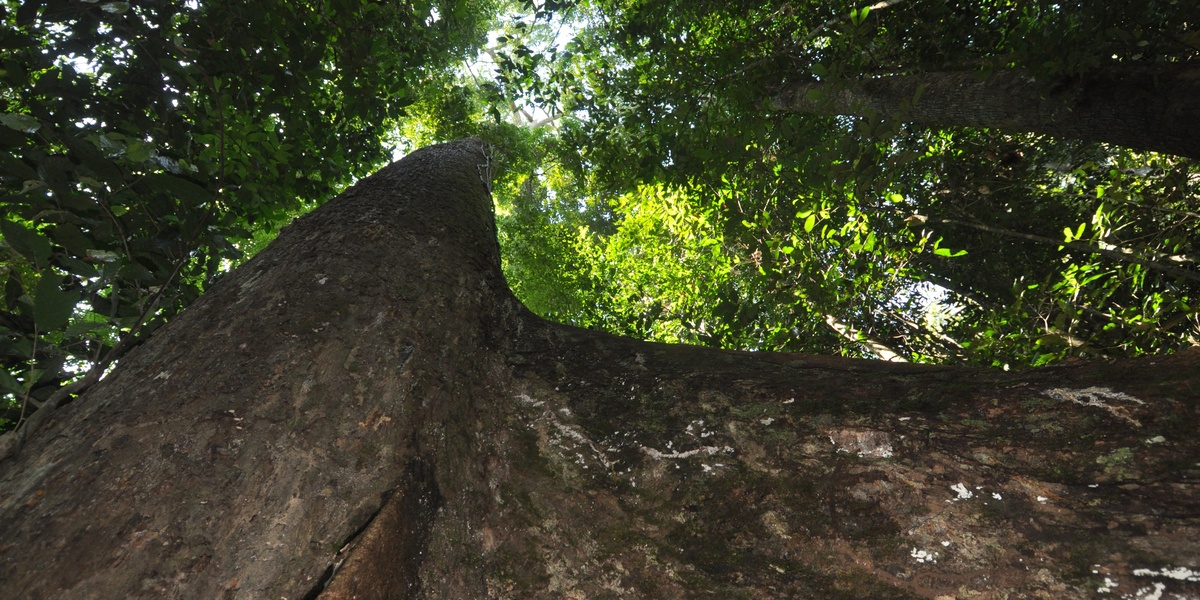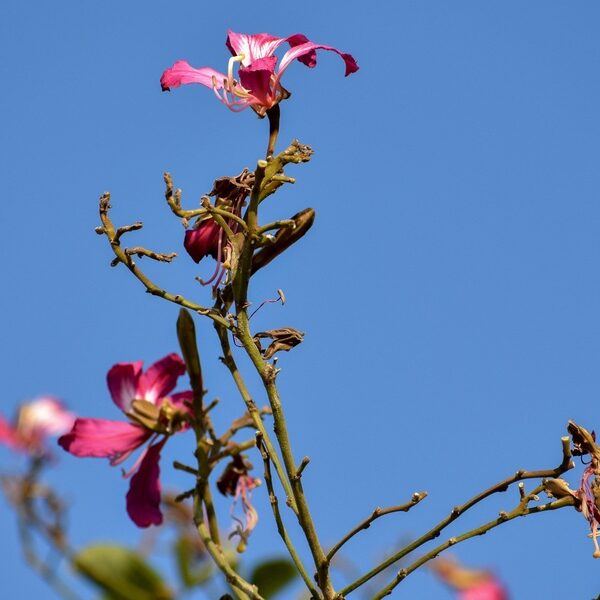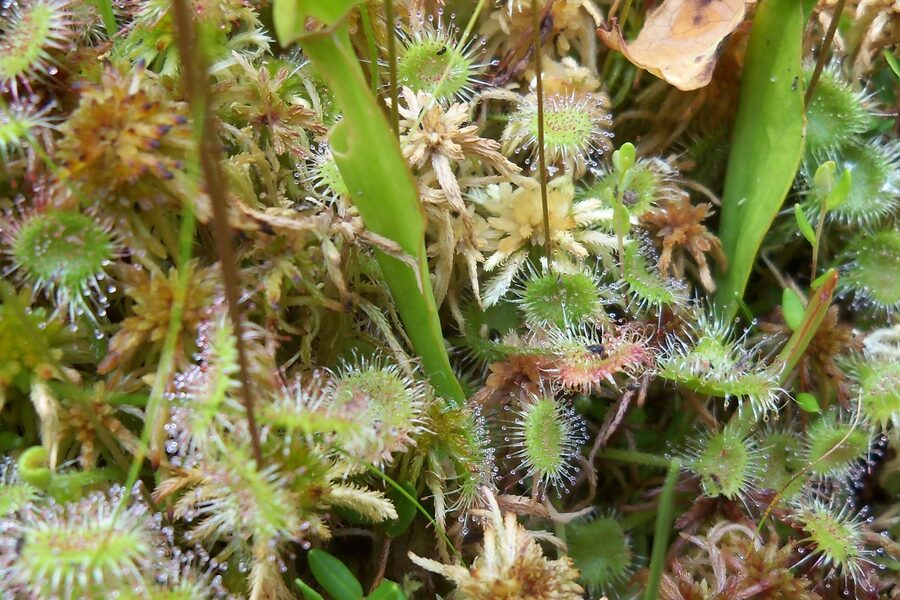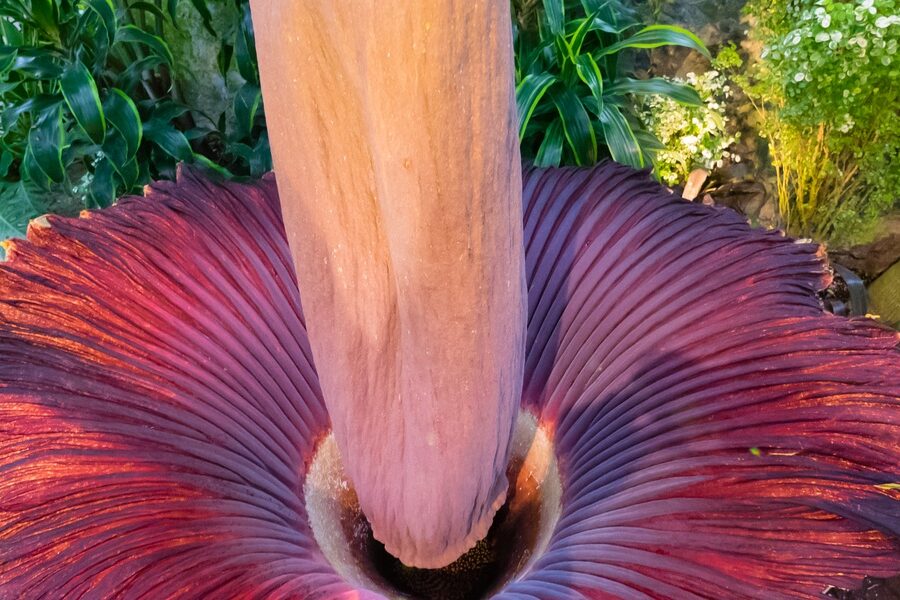Malaysia’s forests, mangroves and city streets host a wide variety of trees that shape the landscape, provide shade, and support local biodiversity. Whether you’re a gardener, student, or nature enthusiast, knowing which species are around helps with identification and conservation.
There are 60 Trees of Malaysia, ranging from Acacia to Yellow Flame. For each entry, the table lists Scientific name, Height (m), Native range/habitat — information you’ll find below.
How can I use the columns to identify a tree I find in the field?
Start by matching leaf, bark and overall height to the table’s Height (m) and Scientific name; the native range/habitat narrows possibilities by location (coastal, lowland, upland, etc.). Use a local field guide or photo app alongside the list for visual confirmation and note flowering or fruiting details to improve accuracy.
Do the entries indicate which species are native versus introduced?
Yes — the Native range/habitat column shows where each species naturally occurs, which helps distinguish native trees from naturalized or planted species; if you need stricter provenance (e.g., conservation status or invasive risk), cross-check with national databases or forestry resources.
Trees of Malaysia
| Common name | Scientific name | Height (m) | Native range/habitat |
|---|---|---|---|
| Tualang | Koompassia excelsa | 60-80 | Peninsular Malaysia, Sabah, Sarawak; lowland rainforests |
| Chengal | Neobalanocarpus heimii | 30-60 | Peninsular Malaysia; lowland dipterocarp forests on well-drained soils |
| Red Meranti | Shorea spp. | 40-70 | Throughout Malaysia; common in lowland and hill dipterocarp forests |
| Belian | Eusideroxylon zwageri | 30-50 | Borneo (Sabah, Sarawak); lowland forests, often near rivers |
| Merbau | Intsia palembanica | 30-50 | Throughout Malaysia; lowland forests and swampy areas |
| Kapur | Dryobalanops aromatica | 40-65 | Peninsular Malaysia, Borneo; lowland dipterocarp forests |
| Keruing | Dipterocarpus spp. | 40-60 | Throughout Malaysia; lowland and hill dipterocarp forests |
| Jelutong | Dyera costulata | 50-70 | Peninsular Malaysia, Borneo; lowland rainforests and freshwater swamps |
| Durian | Durio zibethinus | 20-50 | Peninsular Malaysia, Borneo; cultivated or in lowland rainforests |
| Rambutan | Nephelium lappaceum | 15-25 | Native to Malaysia/Indonesia region; widely cultivated in orchards |
| Mangosteen | Garcinia mangostana | 10-25 | Native to Malaysia/Sunda Islands; cultivated in lowland areas |
| Jackfruit | Artocarpus heterophyllus | 15-20 | Native to region; widespread in villages and orchards |
| Petai | Parkia speciosa | 20-30 | Throughout Malaysia; lowland and hill forests, often cultivated |
| Rubber Tree | Hevea brasiliensis | 20-30 | Introduced from Brazil; widespread in plantations throughout Malaysia |
| Rain Tree | Samanea saman | 15-25 | Introduced from Tropical America; common in parks and roadsides |
| Angsana | Pterocarpus indicus | 20-40 | Native to region; widely planted as an ornamental roadside tree |
| Yellow Flame | Peltophorum pterocarpum | 15-25 | Native to coastal SE Asia; common ornamental in parks and roads |
| Flame of the Forest | Delonix regia | 10-18 | Introduced from Madagascar; widely planted as an ornamental tree |
| Tembusu | Fagraea fragrans | 15-25 | Throughout Malaysia; open woodlands, riverbanks, and secondary forests |
| Bakau Minyak | Rhizophora apiculata | 10-25 | Throughout Malaysian coastlines; mangrove swamp forests |
| Berembang | Sonneratia caseolaris | 5-15 | Coastal Malaysia; mangrove forests, especially along riverbanks |
| Sea Almond | Terminalia catappa | 20-35 | Throughout Malaysian coastlines; sandy and rocky shores |
| Rhu | Casuarina equisetifolia | 20-35 | Coasts of Malaysia; sandy beaches and coastal areas |
| Gaharu | Aquilaria malaccensis | 15-30 | Peninsular Malaysia, Borneo; lowland and hill forests |
| Tongkat Ali | Eurycoma longifolia | 5-10 | Throughout Malaysia; understory of lowland and hill forests |
| Pulai | Alstonia angustiloba | 20-40 | Throughout Malaysia; common in secondary forests and open country |
| Banyan Tree | Ficus benghalensis | 20-30 | Introduced from India; established in parks and temples |
| Strangler Fig | Ficus spp. | 20-40 | Throughout Malaysia; common in all forest types |
| Gelam | Melaleuca cajuputi | 10-20 | Coastal and swampy areas; forms extensive swamp forests |
| Bungor | Lagerstroemia speciosa | 10-25 | Throughout Malaysia; riverbanks and secondary forests |
| Kempas | Koompassia malaccensis | 40-60 | Peninsular Malaysia, Borneo; lowland and peat swamp forests |
| Nyatoh | Palaquium spp. | 30-40 | Throughout Malaysia; lowland and hill dipterocarp forests |
| Teak | Tectona grandis | 30-40 | Introduced from South Asia; established in plantations |
| Mahogany | Swietenia macrophylla | 30-50 | Introduced from Central/South America; plantations and roadsides |
| Acacia | Acacia mangium | 20-30 | Introduced from Australia/PNG; widespread in forest plantations |
| Cinnamon | Cinnamomum verum | 10-15 | Cultivated in various regions; originally from Sri Lanka |
| Clove | Syzygium aromaticum | 10-20 | Cultivated, especially in Penang; native to Indonesia’s Maluku Islands |
| Nutmeg | Myristica fragrans | 10-20 | Cultivated, especially in Penang; native to Banda Islands, Indonesia |
| Neem | Azadirachta indica | 15-20 | Introduced from India; widely planted in residential areas |
| Sentul | Sandoricum koetjape | 20-40 | Native to region; found in villages and forests |
| Jering | Archidendron pauciflorum | 15-25 | Throughout Malaysia; secondary forests and cultivated areas |
| Macaranga | Macaranga spp. | 10-20 | Throughout Malaysia; disturbed areas and secondary forests |
| Penaga Laut | Calophyllum inophyllum | 10-20 | Coasts of Malaysia; sandy and rocky shores |
| Tempinis | Streblus elongatus | 15-30 | Throughout Malaysia; lowland forests and riverbanks |
| Simpoh Air | Dillenia suffruticosa | 3-7 | Throughout Malaysia; open, swampy areas and secondary forests |
| Bintangor | Calophyllum spp. | 20-40 | Throughout Malaysia; diverse habitats from coast to mountains |
| Golden Shower Tree | Cassia fistula | 10-20 | Introduced from Indian subcontinent; popular ornamental tree |
| Frangipani | Plumeria spp. | 5-8 | Introduced from Americas; common in gardens and cemeteries |
| Kapok | Ceiba pentandra | 40-70 | Naturalized in Malaysia; open country and riverbanks |
| Tamarind | Tamarindus indica | 15-25 | Introduced from Africa; widely grown in drier regions |
| Kedondong | Spondias dulcis | 10-20 | Native to Melanesia; widely cultivated for its fruit |
| Jambu Air | Syzygium aqueum | 5-15 | Native to Malaysia; common in home gardens |
| Terap | Artocarpus odoratissimus | 15-25 | Borneo (Sabah, Sarawak); cultivated and in lowland forests |
| Binuang | Octomeles sumatrana | 50-70 | Sabah, Sarawak; riverbanks and alluvial plains in primary forest |
| Damar Minyak | Agathis borneensis | 40-60 | Peninsular Malaysia, Borneo; montane and sub-montane forests |
| Mengkulang | Heritiera spp. | 30-50 | Throughout Malaysia; lowland and hill dipterocarp forests |
| Sepetir | Sindora spp. | 30-50 | Throughout Malaysia; lowland forests and swampy areas |
| Giam | Hopea spp. | 30-40 | Throughout Malaysia; mainly lowland dipterocarp forests on ridges |
| Resak | Vatica spp. | 20-30 | Throughout Malaysia; lowland, swamp, and heath forests |
| Medang | Litsea spp. | 15-30 | Throughout Malaysia; common in primary and secondary forests |
Images and Descriptions

Tualang
One of the tallest tropical trees, with smooth, silvery bark and massive buttress roots. It is famous for hosting giant honeybee nests, making its branches valuable for honey collection. The wood is hard but brittle.
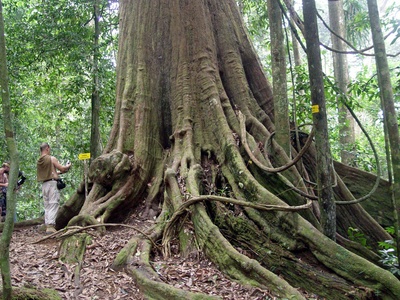
Chengal
A legendary Malaysian hardwood, prized for its extreme durability and resistance to termites. Its heavy, yellowish-brown timber is used for boats and construction. Over-harvesting has made it a threatened species, now heavily protected.

Red Meranti
A group of important timber trees forming the backbone of Malaysia’s rainforests. They are recognized by their winged fruits that spin like helicopters. The reddish timber is a major export for furniture and plywood.
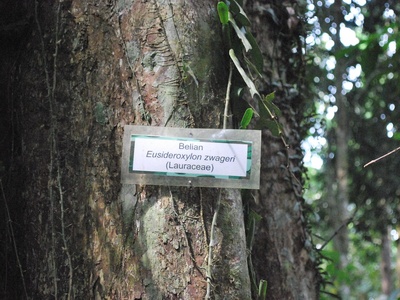
Belian
Known as Bornean Ironwood, its timber is one of the hardest and most durable in the world, resisting rot and insects. It is culturally significant to indigenous communities for building longhouses and coffins. Highly protected.

Merbau
A large, important hardwood tree with a distinctive spreading crown and large buttresses. Its durable, reddish-brown wood is highly valued for flooring and furniture, but this has led to it being over-exploited and now vulnerable.

Kapur
A majestic giant of the forest, known for producing camphor, a crystalline substance with a strong aromatic scent. Its timber is a valuable, light hardwood. The tree has a distinctive crown of cauliflower-like foliage.

Keruing
A large genus of resinous timber trees, easily identified by their large leaves and two-winged fruits. The oleo-resin (keruing oil) is traditionally used for waterproofing boats and as a natural varnish, while the timber is a common construction wood.
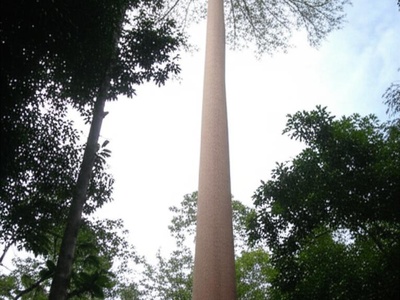
Jelutong
A very tall tree with a straight, clear bole, once prized for its white latex used to make chewing gum. Its soft, lightweight, and fine-grained wood is now popular for wood carving, pattern making, and pencils.

Durian
The famous ‘King of Fruits’, known for its formidable spiky husk and pungent aroma. This large tree produces creamy, custard-like fruit that is a cultural and culinary icon across Southeast Asia and a major agricultural commodity.
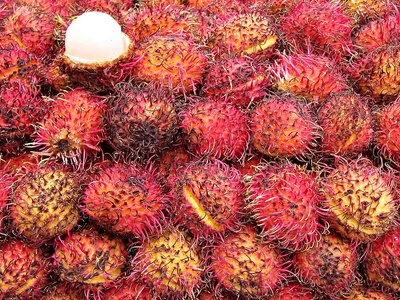
Rambutan
A popular fruit tree with a dense, spreading crown. It produces oval fruits covered in soft, hair-like spines (rambut means ‘hair’ in Malay). The translucent, juicy flesh is sweet and a favorite local snack.
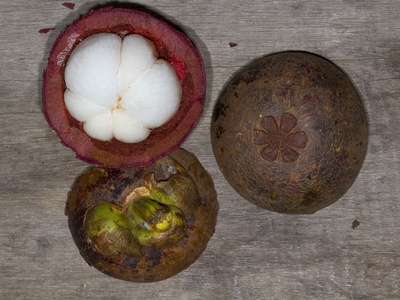
Mangosteen
Hailed as the ‘Queen of Fruits’, this slow-growing tree produces a round, purple fruit with a thick rind. Inside, the sweet, tangy, and fragrant white segments are a delicacy. The tree has a distinctive pyramidal shape.
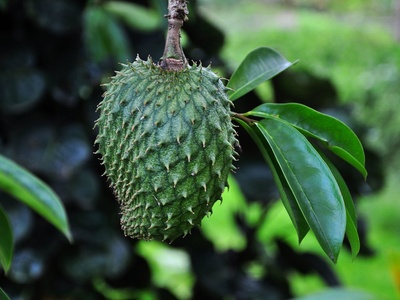
Jackfruit
This tree is famous for producing the largest tree-borne fruit in the world, which can weigh up to 35 kg. The versatile fruit is eaten ripe for its sweet yellow pods or cooked unripe as a vegetable curry.

Petai
A tall tree famous for its long, twisted pods containing bright green beans. Known as ‘stink beans’, they have a unique, pungent smell and strong flavor, and are a popular, though divisive, ingredient in local dishes.

Rubber Tree
Not native, but economically vital to Malaysia for over a century. Its bark is tapped for the milky white latex used to produce natural rubber. The tree has a distinctive straight trunk and leaves with three leaflets.
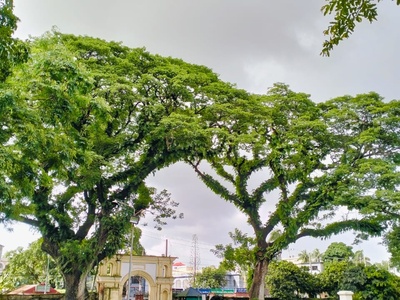
Rain Tree
A classic shade tree with a massive, umbrella-shaped canopy that can be wider than its height. Its leaves fold up at night or on cloudy days, giving it its name. Features attractive pink, pom-pom like flowers.
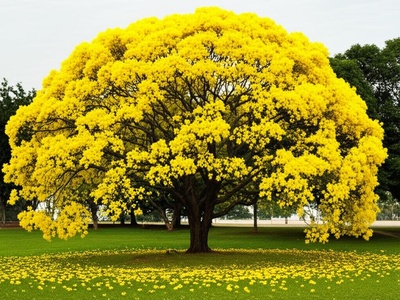
Angsana
A large deciduous tree known for its brief but spectacular bursts of fragrant, bright yellow flowers that carpet the ground below. It yields a valuable red hardwood and has a wide, dome-shaped, drooping crown providing excellent shade.

Yellow Flame
A beautiful ornamental tree that produces spectacular upright clusters of bright yellow, fragrant flowers, especially after a dry spell. Its wide, spreading canopy offers good shade, making it a popular choice for urban landscaping.

Flame of the Forest
A stunning tree famous for its fiery display of scarlet or orange-red flowers that cover the entire crown. With its fern-like leaves and wide, umbrella-shaped canopy, it is one of the most beautiful tropical ornamental trees.
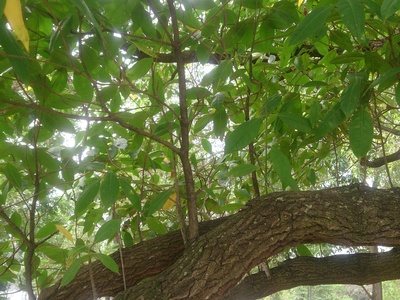
Tembusu
A hardy, slow-growing native tree with deeply fissured dark brown bark and a dense, rounded crown. It is known for its creamy-white, highly fragrant flowers that open in the evening, and its durable, termite-resistant wood.
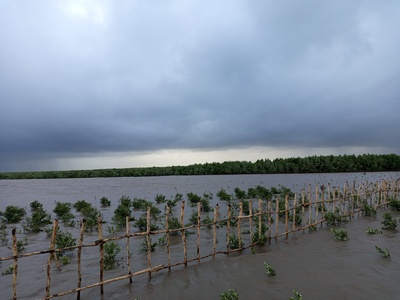
Bakau Minyak
A key mangrove species recognized by its tangled prop and stilt roots that anchor it in soft mud. It plays a vital role in coastal protection and as a nursery for marine life. Its wood is used for charcoal.
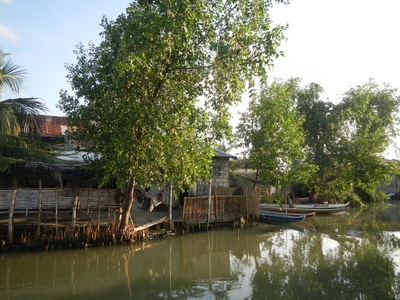
Berembang
A mangrove tree with distinctive conical breathing roots (pneumatophores) that stick out of the mud. Its large, reddish, pom-pom-like flowers open at night to be pollinated by bats, and are a food source for fireflies.
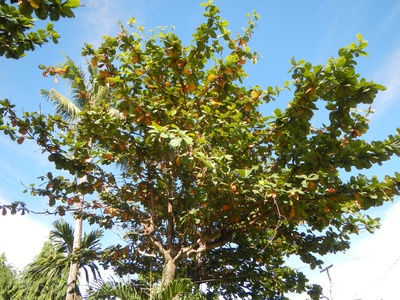
Sea Almond
A common coastal tree with a distinct pagoda-like shape due to its tiered branches. Its large leaves turn red, yellow, and purple before falling. The edible, almond-like kernel is found inside a hard, fibrous fruit.
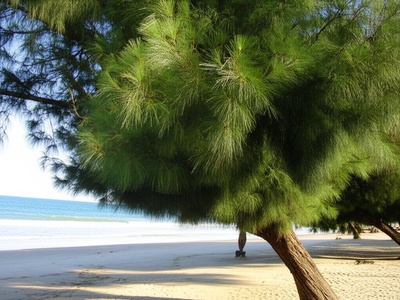
Rhu
Also known as the Casuarina, this coastal tree resembles a pine with its wispy, needle-like foliage. It is very salt-tolerant and wind-resistant, acting as an excellent windbreak and helping to prevent coastal erosion.

Gaharu
This tree produces a dark, fragrant resin known as agarwood or ‘oud’ when infected with a specific mold. This resin is one of the most expensive raw materials in the world, used for incense and perfumes, making the tree critically endangered.
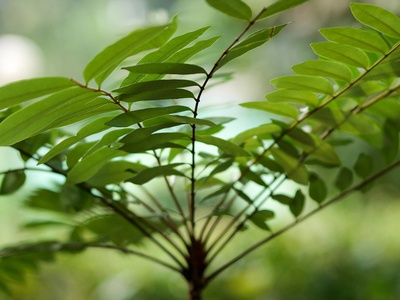
Tongkat Ali
A small, slender tree famous for its medicinal roots, which are traditionally used as a health tonic and aphrodisiac. The plant has long, compound leaves clustered at the top of its trunk, resembling a small palm.

Pulai
A fast-growing pioneer tree with a distinctive pagoda-like branching pattern. Its lightweight, pale wood is used for making floats, disposable chopsticks, and pulp. The tree produces a bitter white latex.
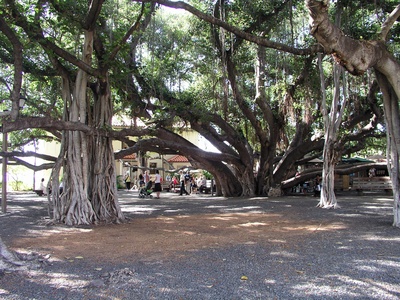
Banyan Tree
A massive fig tree known for its impressive aerial roots that grow down from branches to form new trunks. A single tree can spread to cover a huge area, and is often considered sacred in Hindu and Buddhist cultures.
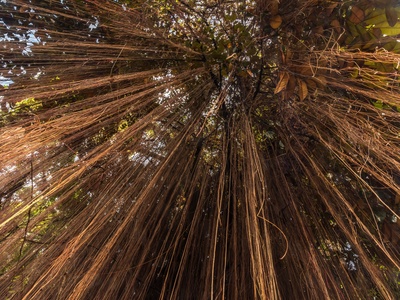
Strangler Fig
These figs begin life as a seed deposited on a host tree. They send down aerial roots that eventually surround and ‘strangle’ the host, forming a massive, hollow-cored tree. They are keystone species, providing fruit for wildlife.
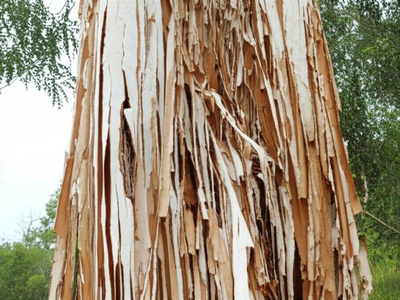
Gelam
Also known as the Cajuput or Paperbark tree, it has a distinctive white, spongy, and flaky bark that can be peeled off in thin layers. Its leaves are distilled to produce cajuput oil, used for medicinal purposes.
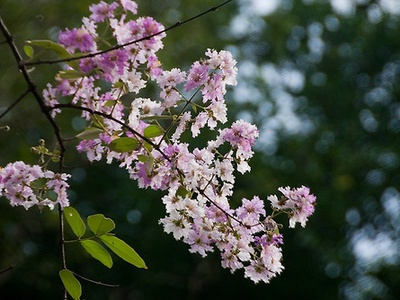
Bungor
A beautiful ornamental tree with a fluted trunk and smooth, peeling bark. It is celebrated for its large, crinkled flowers that come in shades of pink, purple, or lavender, creating a spectacular display when in full bloom.
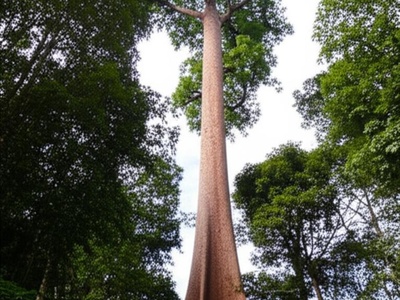
Kempas
A very large emergent tree, related to the Tualang, but with a more fluted or buttressed base. Its extremely hard and heavy wood is used for heavy construction, but its low durability makes it susceptible to termite attack.
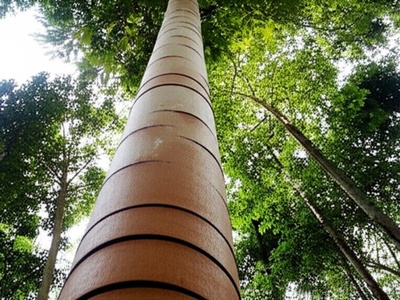
Nyatoh
A group of common forest trees that yield a light to medium hardwood timber. They were once a major source of ‘gutta-percha’, a natural latex used for insulating underwater cables and in dentistry before the advent of synthetics.
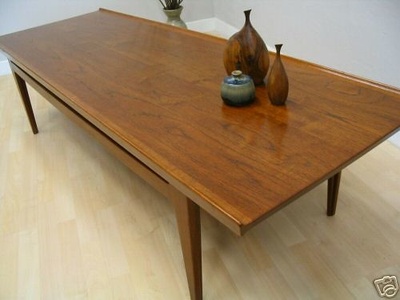
Teak
Known as Jati in Malay, this large deciduous tree is world-renowned for its high-quality timber. The wood is extremely durable, water-resistant, and prized for high-end furniture, boat building, and flooring.

Mahogany
A large, fast-growing tree planted for its valuable timber. The wood is famous for its rich reddish-brown color, workability, and durability, making it a top choice for premium furniture, cabinetry, and musical instruments.
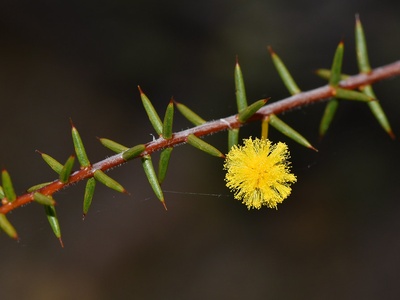
Acacia
A fast-growing tree extensively planted for pulp and paper production and for rehabilitating degraded lands. It has flattened leaf stalks (phyllodes) instead of true leaves and produces creamy-white, fluffy flower spikes.
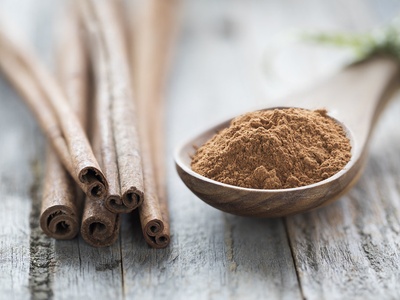
Cinnamon
Known as Kayu Manis, this small evergreen tree is the source of true cinnamon spice. The spice is derived from the inner bark, which is peeled from young shoots and dried into rolls or ‘quills’.
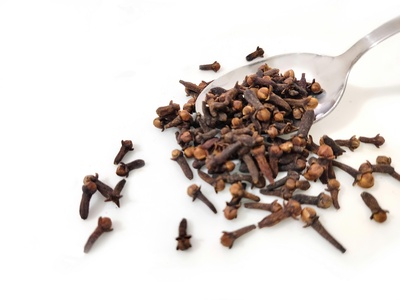
Clove
An evergreen tree that produces the aromatic flower buds known as cloves (Cengkih). The unopened buds are harvested and dried, then used as a pungent spice in cooking, traditional medicine, and to make clove cigarettes.

Nutmeg
The source of two spices: nutmeg (from the seed) and mace (from the red, lacy covering of the seed). This evergreen tree was historically a driver of the spice trade and a reason for colonial interest in the region.
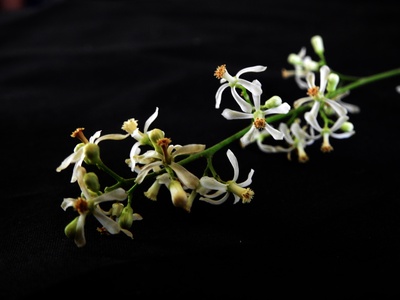
Neem
A hardy, fast-growing evergreen tree valued for its medicinal properties. Almost every part of the tree—leaves, bark, seeds—is used in traditional remedies and organic pesticides. It has a reputation as a ‘village pharmacy’.
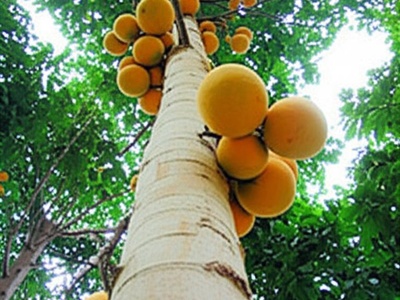
Sentul
A large fruit tree with a straight trunk and pale bark. It produces a round, yellowish fruit with a thick, velvety rind. The sweet or sour white pulp surrounding the seeds is eaten fresh or used in cooking.

Jering
A tree known for its large, coiled purple-black pods containing disc-shaped beans. Similar to Petai, Jering beans have a very strong smell and are eaten after boiling or roasting, but can be toxic if consumed raw in large quantities.
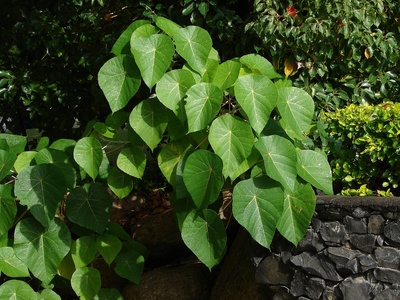
Macaranga
A genus of pioneer trees, often called ‘ant-plants’ because many species have hollow stems that house colonies of ants in a symbiotic relationship. They are fast-growing and essential for forest regeneration.

Penaga Laut
A beautiful, hardy coastal tree with a broad, spreading crown of glossy, dark green leaves. It produces fragrant white flowers and round, green fruits. The oil from its seeds (Tamanu oil) is valued for cosmetic and medicinal uses.

Tempinis
A native hardwood tree with a dense, rounded crown. Its timber is extremely hard, heavy, and durable, traditionally used for making tool handles, house posts, and mallets for traditional Gamelan orchestras.
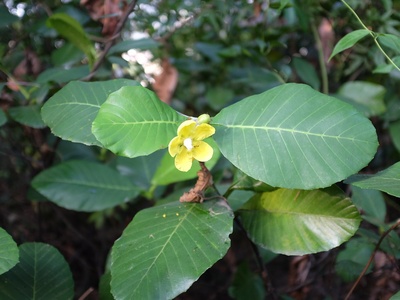
Simpoh Air
A large shrub or small tree, easily recognized by its large, cabbage-like leaves with prominent veins and huge, bright yellow flowers. The leaves were traditionally used for wrapping food like tempeh.

Bintangor
A large genus of trees, some of which have shown promise in medical research. An extract from one species, Calophyllum lanigerum, found in Sarawak, was studied for its potential anti-HIV properties in the 1990s.
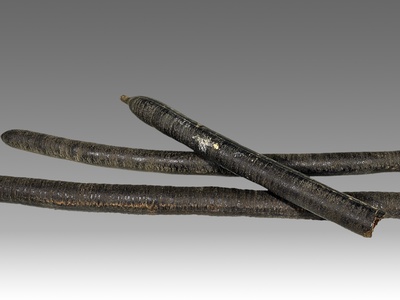
Golden Shower Tree
A stunning medium-sized tree famous for its spectacular display of long, drooping clusters of bright yellow flowers. After flowering, it produces long, dark brown cylindrical seed pods that hang from the branches.
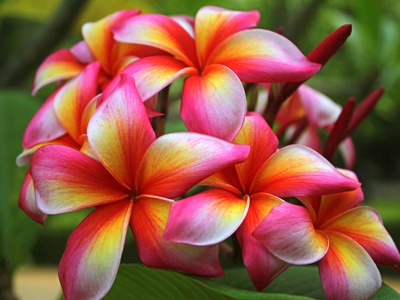
Frangipani
Also known as Kemboja, this small, spreading tree is famous for its waxy, intensely fragrant flowers that come in white, yellow, pink, and red. The tree has thick, succulent branches that exude a milky latex when broken.

Kapok
A massive tree with a thick, buttressed trunk often covered in conical spines. It produces large pods filled with a fluffy, cotton-like fiber (kapok) that is water-resistant and buoyant, traditionally used to stuff pillows and life preservers.

Tamarind
Known locally as Asam Jawa, this long-lived tree has a dense crown of feathery leaves. It produces brown pods containing a tart, sticky pulp that is a key souring agent in Malaysian and international cuisine.

Kedondong
A fast-growing fruit tree that produces clusters of oval green fruits. The flesh is crisp, crunchy, and has a pleasant sweet-tart flavor, often eaten fresh with salt and chili, or juiced. It has a spiky, fibrous core.
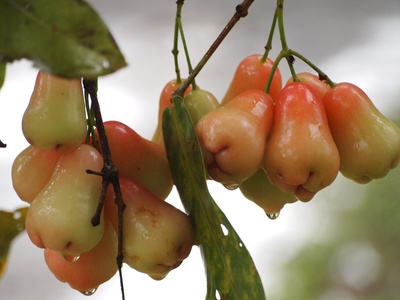
Jambu Air
A small tree that produces bell-shaped, waxy fruit, known as water apple. The fruit can be pink, red, or white, and has a crisp, watery texture and a mild, sweet flavor, making it a refreshing snack.

Terap
A fruit tree related to jackfruit and cempedak, native to Borneo. It produces a large, round fruit with a soft, spiky exterior. The sweet, creamy white flesh is very aromatic and is considered a delicacy.

Binuang
A gigantic, fast-growing pioneer tree with massive buttresses and a wide, spreading crown. Its soft, lightweight timber is used for making canoes, packing cases, and matches. It colonizes open areas along rivers quickly.

Damar Minyak
A large coniferous tree, part of an ancient family of plants. It has a distinctive smooth, greyish bark that flakes off in plates. The tree produces a valuable resin (damar) and has a straight trunk prized for timber.
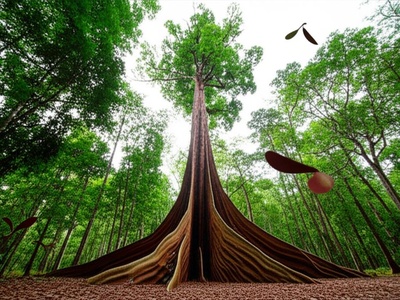
Mengkulang
A group of large timber trees often with prominent buttresses. The wood is a popular medium hardwood, but the most interesting feature is the winged fruit of some species, which spins as it falls from the high canopy.
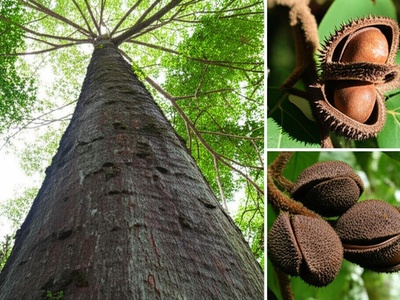
Sepetir
Large timber trees known for their distinctive circular, flattened, spiny pods. The wood has an attractive grain and is used for furniture and general construction. The tree also yields a commercially valuable oil or resin.
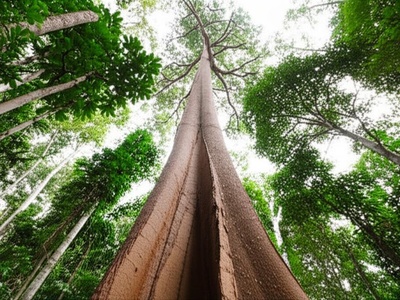
Giam
A genus of dipterocarp trees that yield a very heavy, hard, and durable timber. Giam is highly resistant to decay and was traditionally used for salt-water piling, boat building, and other heavy-duty applications.
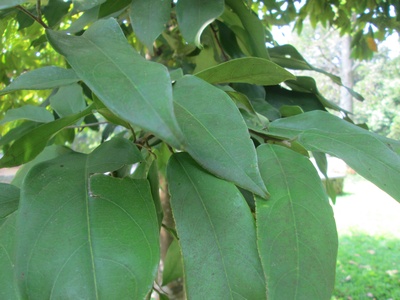
Resak
A group of small to medium-sized trees that produce a heavy hardwood timber also known as Resak. The wood is very durable and used for heavy construction. Many species are now threatened due to habitat loss.

Medang
A large and diverse genus of trees from the laurel family, related to cinnamon. Many Medang species are aromatic and yield lightweight to medium-weight timber used for furniture, construction, and plywood.
